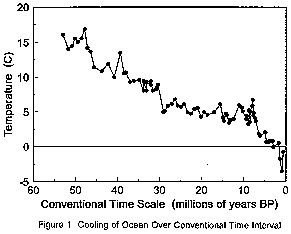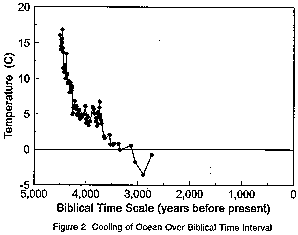If ". . . all the high hills, that were under the whole heaven, were covered" by the Flood and ". . . all flesh died that moved upon the earth . . ." as described in Genesis 7:19,21, then it is likely that massive global upheavals of the crust and oceans were involved. If the geologic column is a record of catastrophic events of the Flood over a period of about a year some 5,000 years ago, then large quantities of heat would have been released from eruptions of magma in volcanoes and the mid-ocean ridges, from frictional forces of erosion, and from crustal motions such as continental breakup, plate subduction, and earthquakes. Because the oceans would have been in direct contact with many of the sources of heat, the water would have been warmed and remained so for some time following the Flood. [1]
Layers of sediment averaging over 1000 feet thick cover the sea floor all over the earth. Samples of these sediments have been extracted by deep sea drilling techniques which have led to a better understanding of earth history. Sea-floor sediments not only contain sand and mud eroded from the continents, but also shells of microorganisms which lived and died in the ocean. Some of these microorganisms called foraminifera incorporate varying quantities of oxygen isotopes into their shells as the temperature changes, allowing them to be used as a paleothermometer—an instrument for estimating temperature in the past.
Kennett et al. [2] have analyzed the concentration of oxygen isotopes in foraminifera which live on the sea floor near the Antarctic. Using a conventional time scale which assumes that the sea-floor sediments have accumulated over millions of years at a rate similar to that observed today, they found a slow decrease in temperature of about 20°C since the end of the Cretaceous Period about 65 million years ago. Figure 1 shows the results of their research which is used as one of the justifications for believing that the Cretaceous Period when the dinosaurs lived was so warm.

However, if these same data are interpreted from a young-earth catastrophic Flood perspective, an entirely different result is found. Using a Biblical time scale which assumes that the sea-floor sediments have accumulated mostly over a few thousand years during and following the Genesis Flood, initially at a very high rate and decreasing exponentially to that observed today, Vardiman [3] found a rapid decrease in temperature immediately after the Flood followed by a slower decrease with time. Figure 2 shows most of this cooling to have only taken only about 2000 years to reach temperatures commonly observed today.
The shape of the cooling curve in figure 2 is similar to that expected by a body starting at a high temperature and cooling by heat transfer to a cooler reservoir. The rate of cooling is rapid initially but slows with time, approaching the final temperature asymptotically. During the steep portion of the cooling curve, the climate of the earth would be expected to change dramatically as the oceans cooled by some 20°C. Today, when the ocean surface averages only one or two degrees warmer during an El Nino event, major changes occur in circulation and precipitation patterns over the Pacific Ocean leading to major storms and flooding on the west coasts of North and South America. How much more dramatic would climate changes be for a 20°C cooling?
If the model of sea-floor sediment accumulation described above is correct, the implications are dramatic. Most of the sediments found on the sea floor were deposited rapidly just a few thousand years ago. The rate of accumulation would have been very rapid during and immediately following the Flood. Not only would erosion of sands and muds from the continents have been involved, but also the accumulation of microscopic plant and animal organisms from the ocean itself. This would indicate that the tiny organisms in the ocean probably "bloomed" following the Flood due to all the nutrients added by the Flood and the greater warmth, as well as fewer large predators allowing a continued, rapid doubling of biomass.

The warm ocean would have produced at least four significant atmospheric effects. Much greater evaporation of water vapor from the ocean to the atmosphere would have led to greater storminess and precipitation, particularly in the polar regions. Large temperature contrasts between the oceans and continents would have produced strong winds and heavy precipitation parallel to coast lines. The blooming of ocean life following the Flood would likely have absorbed large quantities of carbon dioxide from the atmosphere causing radiational cooling. Warm oceans and radiational cooling aloft would create more convection in the atmosphere leading to more precipitation.
The atmospheric effects appear to be an adequate explanation for the "Ice Age" which produced more extensive glaciers than today and massive sheets of ice over large areas of the polar regions and mid-latitudes. [4] The "Ice Age" in the Biblical time frame probably lasted from shortly after the Flood to about the time of Abraham. The "Ice Age" probably affected the peoples of the Bible with a cooler, wetter climate and more grasslands in the Tigris-Euphrates Valley, Palestine, and North Africa. These regions are known for their desert climate today, but evidence points to more vegetation in the past.
Once the oceans cooled to the equilibrium temperatures of today, the climate reached a stable condition with only relatively minor variations. Generally, the world's climate would be expected to be drier as less moisture was transported into the atmosphere from a cooler ocean, winds along continental boundaries weakened, less carbon dioxide was removed from the atmosphere leading to warming atmospheric temperatures, and convection decreased. Variations in climate would be primarily produced by seasonal changes rather than highly energetic storms and cooling of the ocean.
Rapid accumulation of sea-floor sediments during and following the Flood imply that the ocean cooled rapidly over the past few thousand years. This rapid cooling explains the cause of the "Ice Age" and other climate changes. Rather than being a puzzle for young-earth creationists, thick layers of sediment on the sea floor and massive sheets of ice on the continents appear to be a consequence of the catastrophic events of the Genesis Flood. Once again Biblical accounts of earth history are being confirmed, lending credibility to God's Word.
It is recommended that the young-earth model of sea-floor sediment accumulation proposed here be improved by analyzing the oxygen and carbon isotopes from many additional cores. The identification of the Flood/Post-Flood boundary needs to have high priority. An analysis of the production of sediments containing shells of living organisms in a post-Flood ocean should be made and compared with the mass of sediments observed. The accumulation of hundreds of feet of sediment, on the average, and miles of sediment in some locations, such as the Arctic Ocean, require very high production following the Flood. Although the potential for high productivity has been suggested by some, can the oceans supply enough nutrients in some 4,500 years to explain the observed sediments?
[1] Oard, M.J. 1990. An Ice Age Caused by the Genesis Flood. Institute for Creation Research Monograph. San Diego, CA. 243 pp.
[2] Kennett, J.P., Houtz R.E. , Andrews , P.B. Edwards, A.R., Gostin ,V.A., Hajos M., Hampton, M. , Jenkins, D.G., SW., Margolis, A.T. Ovenshine, K. Perch-Nielsen. 1977. Descriptions of Procedures and Data for Sites 277, 279, 281 by the Shipboard Party. In Initial Reports of the Deep Sea Drilling Project. 29:4558, 191-202, and 271-285. GPO: Washington, D.C.
[3] Vardiman, L. 1996. Sea-Flood Sediment and the Age of the Earth. Institute for Creation Research Monograph. San Diego, CA. 94 pp.
[4] Vardiman, L. 1996. Ice Cores and the Age of the Earth. Institute for Creation Research Monograph. San Diego, CA. 86 pp.
*Dr. Vardiman is Chairman of the Physics Department of I.C.R.



